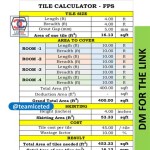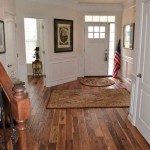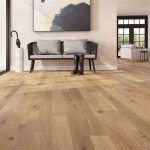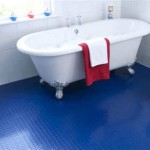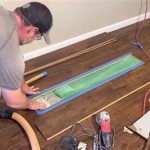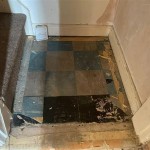Can I Install Laminate Flooring On A Wall? A Comprehensive Guide
Laminate flooring, typically associated with horizontal surfaces, has increasingly garnered attention as a potential wall covering. The appeal lies in its durability, aesthetic versatility, and relative ease of installation compared to some traditional wall treatments. However, the suitability of laminate for wall application warrants careful consideration, encompassing factors such as the type of laminate, the wall structure, and the intended aesthetic.
The exploration of laminate flooring as a wall covering involves understanding its composition and characteristics. Laminate consists of multiple layers fused together. The core layer, often made of high-density fiberboard (HDF) or medium-density fiberboard (MDF), provides stability and impact resistance. A decorative layer, featuring a printed image resembling wood, stone, or tile, is applied on top of the core. Finally, a transparent wear layer protects the decorative layer from scratches, stains, and fading.
When considering using laminate on walls, several factors play critical roles in the success and longevity of the installation. The choice of adhesive, the preparation of the wall surface, and the installation technique are all crucial elements that must be meticulously executed.
1. Assessing the Suitability of Laminate for Wall Application
Not all laminate flooring is created equal, and its suitability for wall application hinges on several properties. Thinner and lighter laminates are generally preferred for walls due to their reduced weight, which minimizes stress on the wall structure and simplifies the installation process. Thicker, heavier laminates, designed for high-traffic floors, can be more challenging to install and may require stronger adhesives and additional support.
The locking mechanism of the laminate is another important consideration. Some laminates feature a click-lock system that interlocks the planks or tiles together. While this system is efficient for floor installation, it can present challenges on walls, especially when dealing with complex layouts or corners. Gluing the laminate directly to the wall surface may be necessary to securely hold the pieces in place.
The moisture resistance of the laminate is also a pertinent factor, particularly in bathrooms or kitchens. While laminate is generally more moisture-resistant than solid wood, it is not entirely waterproof. Prolonged exposure to moisture can cause the laminate to swell, warp, or delaminate. Therefore, selecting a laminate with a high moisture resistance rating is recommended for areas prone to humidity or spills. Furthermore, proper sealing of the edges and seams is crucial to prevent moisture from penetrating behind the laminate.
Finally, consider the fire rating of the laminate. Building codes often specify fire-resistance requirements for wall coverings, especially in commercial or multi-family dwellings. Ensure that the laminate meets the applicable fire safety standards for the intended application.
2. Wall Preparation and Adhesive Selection
Proper wall preparation is paramount for a successful laminate installation. The wall surface must be clean, dry, and structurally sound. Remove any existing wall coverings, such as wallpaper or loose paint. Repair any cracks or holes in the wall using patching compound. Sand the wall smooth to create a uniform surface for adhesion.
Priming the wall is highly recommended. Primer seals the surface, improves adhesive bond, and helps prevent moisture from penetrating the wall. Choose a primer that is compatible with both the wall material and the adhesive. Allow the primer to dry completely before proceeding with the laminate installation.
Selecting the right adhesive is crucial for ensuring a strong and durable bond between the laminate and the wall. Construction adhesive, specifically designed for bonding wood or laminate to various surfaces, is generally the preferred choice. Look for an adhesive that is compatible with laminate flooring and suitable for vertical applications. Follow the manufacturer's instructions carefully when applying the adhesive. Apply the adhesive evenly across the back of the laminate plank or tile, ensuring adequate coverage, especially around the edges.
For heavier laminates or installations in high-moisture areas, consider using a combination of adhesive and mechanical fasteners, such as nails or screws. The mechanical fasteners provide additional support and prevent the laminate from shifting or detaching from the wall. Ensure that the fasteners are properly countersunk to avoid protruding from the surface of the laminate.
3. Installation Techniques and Considerations
Before starting the installation, plan the layout carefully. Measure the wall and calculate the number of laminate planks or tiles needed. Consider the placement of electrical outlets, light switches, and other fixtures. Determine the starting point and the direction of the installation.
When installing laminate on walls, it is generally recommended to start at the bottom and work upwards. This allows the weight of the upper rows to be supported by the lower rows. Use shims or spacers to maintain consistent spacing between the laminate and the floor or ceiling. This expansion gap allows for natural movement of the materials due to changes in temperature and humidity.
Apply the adhesive to the back of the first laminate plank or tile and press it firmly against the wall. Use a level to ensure that the piece is perfectly aligned. If using mechanical fasteners, drive them into the wall through the laminate, along the edges or in inconspicuous areas. Continue installing the remaining planks or tiles, interlocking them together if applicable. Ensure that each piece is securely adhered to the wall and properly aligned with the adjacent pieces.
When cutting laminate to fit around corners, fixtures, or other obstacles, use a saw with a fine-tooth blade. A jigsaw or circular saw can be used, but a miter saw provides the most precise cuts, especially for angled corners. Always wear safety glasses and ear protection when cutting laminate.
After the installation is complete, inspect the wall carefully for any gaps or imperfections. Fill any gaps with color-matched caulk or sealant. Clean the surface of the laminate with a damp cloth to remove any adhesive residue or dust.
Considerations should also be made for outlets and light switches. Accurately measure and cut the laminate to fit around these fixtures. Use outlet extenders if necessary to bring the outlets flush with the surface of the laminate. Remember to turn off the power to the circuit before working around electrical fixtures.
The use of trim and molding can significantly enhance the finished appearance of a laminate wall. Trim can be used to cover the edges of the laminate, conceal any gaps, and provide a professional-looking finish. Choose trim that complements the style and color of the laminate. Install the trim using adhesive or nails.
Finally, ongoing maintenance is crucial for preserving the appearance and longevity of the laminate wall. Clean the surface regularly with a damp cloth and a mild detergent. Avoid using abrasive cleaners or harsh chemicals, as they can damage the wear layer. Promptly wipe up any spills to prevent staining or moisture damage. Inspect the wall periodically for any signs of damage, such as scratches, chips, or loose planks. Repair any damage promptly to prevent further deterioration.
While laminate flooring can offer an aesthetic and relatively durable wall covering solution, meticulous planning, preparation, and execution are essential. The weight of the material, the suitability of the adhesive, and potential moisture exposure are factors demanding careful attention to ensure a successful and long-lasting installation.

Going Up The Wall Installing Flooring Vertically Floor Trends Installation

Can You Use Laminate Flooring On Walls Theplywood Com

3 Clever Ways To Use Laminate Flooring On Walls Floors Now

Home Dzine Improvement Create A Feature Wall With Laminate Flooring

Mrs Hinch Fan Puts B Q Laminate Flooring On Her Wall And People Can T Get Enough Daily Record

How To Install A Laminate Wood Wall Citygirl Meets Farmboy

Laminate And Vinyl Cladding Finfloor

How To Use Wooden Flooring As A Stunning Feature Wall Discount Depot Blog
The Secret Of Laminated Walls How To Make Them Look Like They Ve Been There Forever

Laminate Flooring Wall Hometalk
Related Posts

